The rain barrels market is projected to grow from USD 0.9 billion in 2025 to USD 1.6 billion by 2035, adding USD 0.7 billion in new revenue and advancing at a 6.5% CAGR, driven by heightened water-scarcity pressures, expanding municipal conservation mandates, and rising residential interest in decentralized rainwater harvesting. Plastic rain barrels, holding 62.0% share, dominate due to corrosion resistance, weather durability, lightweight installation, and cost efficiency, while standard barrel designs account for 58.0% of demand as homeowners adopt simple, compatible storage units for garden irrigation and outdoor cleaning. Medium-capacity systems (50–100 gallons) gain traction as balanced storage solutions aligned with typical household water-use patterns, while modular, decorative, and collapsible formats begin capturing premium and space-constrained markets.
Residential properties remain the primary end-use segment supported by rebate programs and drought-response policies, whereas commercial and institutional sites expand adoption through landscaping and sustainability initiatives. Regionally, Australia (8.1% CAGR) and Canada (7.5% CAGR) lead growth through active water-restriction frameworks and subsidy-backed installations; the United States (6.8%), India (7.8%), United Kingdom (6.2%), and Germany (6.0%) sustain momentum through environmental awareness and home-improvement trends.
Competitive advantage is consolidating around weather-resistant materials, mosquito-proofing systems, overflow management design, and compatibility with drip-irrigation and garden automation platforms. Companies including Good Ideas Inc., Gardener’s Supply Company, Algreen Products, Enviro World Corporation, FCMP Outdoor, RTS Companies, Achla Designs, Exaco Trading Company, and Rescue Brand strengthen positioning through retail partnerships, aesthetic differentiation, and smart rainwater-monitoring integration.
A key market dynamic is the growing emphasis on household-level water management. With urban populations rising and municipal water bills increasing, homeowners are increasingly investing in rain barrels to reduce dependency on mains water for everyday outdoor use. Demand is especially strong in North America and Europe, where suburban housing stock and dedicated gardens create consistent application opportunities. Rain barrels also appeal to urban consumers seeking compact, space-efficient solutions for balcony gardening, terrace plants, and small-scale landscaping projects. Their ease of installation, low maintenance requirements, and immediate cost-saving benefits support widespread residential adoption.
Government and municipal incentives play an important role in market growth. Many local authorities encourage rainwater collection by offering rebates, subsidies, and educational programs that promote rain barrel use for stormwater management. These initiatives help reduce pressure on drainage systems, lower flood risk during heavy rainfall, and support community greening programs. As cities invest in climate-resilient infrastructure and stormwater control, rain barrels are gaining recognition as practical components of distributed runoff management.
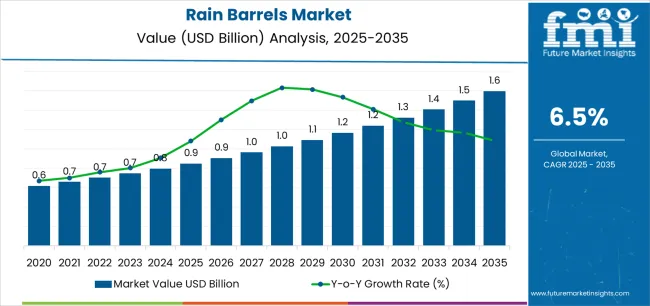
| Period | Primary Revenue Buckets | Share | Notes |
|---|---|---|---|
| Today | Standard barrel sales (50-100 gallon) | 52% | Direct purchase, retail distribution |
| Accessories & connection kits | 18% | Diverters, filters, spigots | |
| Installation services | 15% | Professional setup, system integration | |
| Premium/designer models | 15% | Decorative barrels, custom designs | |
| Future (3-5 yrs) | Smart collection systems | 35-40% | IoT integration, automated monitoring |
| Modular stackable systems | 25-30% | Expandable capacity, scalable solutions | |
| Integrated filtration packages | 15-20% | Advanced purification, multi-stage systems | |
| Subscription maintenance | 10-15% | Cleaning services, seasonal optimization | |
| Digital monitoring services | 8-12% | Water usage analytics, leak detection | |
| Standard models | 10-15% | Basic residential barrels |
| Metric | Value |
|---|---|
| Market Value (2025) | USD 0.9 billion |
| Market Forecast (2035) | USD 1.6 billion |
| Growth Rate | 6.5% CAGR |
| Leading Material | Plastic Rain Barrels |
| Primary Application | Residential Segment |
The market demonstrates strong fundamentals with plastic rain barrel systems capturing a dominant share through cost-effective water storage capabilities and residential water conservation optimization. Residential applications drive primary demand, supported by increasing water scarcity concerns and utility cost management requirements. Geographic expansion remains concentrated in developed markets with established water conservation programs, while emerging economies show accelerating adoption rates driven by water stress initiatives and rising environmental awareness.
Primary Classification: The market segments by material type into plastic, wood, metal, and fiberglass rain barrels, representing the evolution from basic storage containers to sophisticated water collection solutions for comprehensive residential water management optimization.
Secondary Classification: Capacity segmentation divides the market into small capacity (up to 50 gallons), medium capacity (50 to 100 gallons), and large capacity (above 100 gallons) sectors, reflecting distinct requirements for property size, water collection volume, and storage efficiency standards.
Tertiary Classification: Design type segmentation covers standard barrels, decorative barrels, and collapsible barrels, while end-use applications span residential properties, commercial buildings, institutional facilities, and agricultural operations.
Regional Classification: Geographic distribution covers North America, Latin America, Western Europe, Eastern Europe, East Asia, South Asia Pacific, and Middle East & Africa, with developed markets leading adoption while emerging economies show accelerating growth patterns driven by water conservation programs.
The segmentation structure reveals technology progression from standard storage containers toward sophisticated collection systems with enhanced features and automation capabilities, while application diversity spans from residential properties to commercial facilities requiring reliable rainwater harvesting solutions.
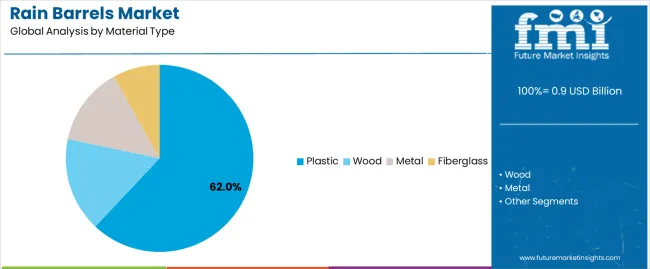
Market Position: Plastic Rain Barrels systems command the leading position in the rain barrels market with 62% market share through cost-effective storage features, including superior weather resistance, lightweight construction, and residential water collection optimization that enable property owners to achieve optimal water conservation across diverse residential and commercial environments.
Value Drivers: The segment benefits from homeowner preference for affordable storage systems that provide consistent water collection performance, easy installation, and maintenance efficiency optimization without requiring significant infrastructure modifications. Advanced design features enable integrated mosquito screens, multiple outlet configurations, and compatibility with existing gutter systems, where operational performance and durability represent critical property requirements.
Competitive Advantages: Plastic Rain Barrels systems differentiate through proven weather resistance, consistent storage characteristics, and integration with residential water management systems that enhance property effectiveness while maintaining optimal durability standards suitable for diverse climate applications.
Key market characteristics:
Wood Rain Barrel systems maintain a 18% market position in the rain barrels market due to their aesthetic appeal and natural material properties. These systems appeal to properties requiring decorative water storage with premium visual appeal for upscale residential applications. Market growth is driven by landscaping integration, emphasizing attractive storage solutions and environmental aesthetics through traditional barrel designs.
Metal Rain Barrels capture 12% market share through superior durability requirements in commercial facilities, long-term installations, and institutional applications. These facilities demand robust storage systems capable of handling high-volume collection while providing effective water management capabilities and structural integrity.
Fiberglass Rain Barrels account for 8% market share through specialized applications requiring lightweight construction, superior corrosion resistance, and premium durability in coastal and high-moisture environments.
Market Context: Medium Capacity barrels demonstrate the highest growth rate in the rain barrels market with 7.2% CAGR due to widespread adoption of balanced storage systems and increasing focus on residential water management optimization, installation convenience, and property water collection applications that maximize harvesting volume while maintaining space efficiency.
Appeal Factors: Medium Capacity barrel users prioritize storage versatility, space efficiency, and integration with existing residential downspout systems that enable effective water collection across typical rainfall events. The segment benefits from substantial residential adoption and home improvement programs that emphasize the acquisition of medium capacity systems for garden irrigation and outdoor water use applications.
Growth Drivers: Water conservation programs incorporate medium capacity barrels as standard equipment for residential properties, while drought management initiatives increase demand for balanced storage capabilities that comply with local regulations and minimize installation complexity.
Market Challenges: Seasonal usage patterns and freeze-thaw cycles may limit year-round utilization across different climate zones or weather scenarios.
Application dynamics include:
Small Capacity applications capture market share through starter system requirements in apartment properties, limited space installations, and trial adoption applications. These properties demand compact storage systems capable of operating within space constraints while providing effective water collection access and operational simplicity capabilities.
Large Capacity applications account for market share, including commercial properties, institutional facilities, and agricultural operations requiring maximum storage volume for operational optimization and extensive irrigation requirements.
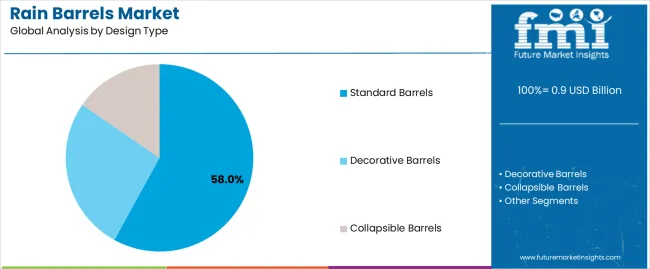
Market Position: Standard Barrels command significant market position with 58% share through functional design that meets cost-effectiveness and practical water storage for diverse residential applications.
Value Drivers: This design type provides the optimal combination of storage capacity and affordability, meeting requirements for basic water collection, outdoor use applications, and residential properties without excessive aesthetic or customization requirements.
Growth Characteristics: The segment benefits from broad applicability across residential sectors, standardized barrel specifications, and established manufacturing programs that support widespread adoption and operational efficiency.
Decorative Barrels maintain 28% market share through aesthetic integration requirements in visible locations, landscaped properties, and upscale residential applications where visual appeal and property enhancement represent important considerations alongside functional water storage.
Collapsible Barrels account for 14% market share through specialized applications requiring seasonal storage, space-saving designs, and portable water collection for temporary installations or limited storage availability scenarios.
Market Context: Residential Properties dominate the market with 7.1% CAGR, reflecting the primary demand source for rain barrel technology in home water conservation and garden irrigation operations.
Business Model Advantages: Residential applications provide direct market demand for water collection equipment, driving technology adoption and storage innovation while maintaining cost accessibility and installation convenience requirements.
Operational Benefits: Residential applications include garden watering, lawn maintenance, and outdoor cleaning that drive consistent demand for collection equipment while providing access to water conservation benefits and utility cost savings.
| Category | Factor | Impact | Why It Matters |
|---|---|---|---|
| Driver | Water scarcity & drought management (climate change, regional water stress) | ★★★★★ | Increasing water restrictions and utility costs drive residential adoption of water conservation solutions with immediate cost savings and environmental benefits. |
| Driver | Municipal water conservation programs & incentive schemes | ★★★★★ | Government rebates and conservation mandates turn rain barrels from "optional" to "encouraged"; municipalities offering subsidies accelerate market penetration. |
| Driver | Rising utility costs & water pricing pressure | ★★★★☆ | Homeowners seek cost reduction alternatives; rain barrels provide measurable ROI through reduced municipal water consumption for outdoor applications. |
| Restraint | Seasonal usage limitations & freeze-thaw concerns | ★★★★☆ | Cold climate regions require seasonal draining and storage; limits year-round utility and increases maintenance complexity in northern markets. |
| Restraint | Space constraints & aesthetic concerns | ★★★☆☆ | Urban properties and homeowners associations may restrict barrel placement; visible installations face appearance objections limiting adoption potential. |
| Trend | Smart water monitoring & IoT integration | ★★★★★ | Connected barrels with capacity sensors, automated usage tracking, and weather forecasting enable optimized water management and integration with smart home systems. |
| Trend | Modular & expandable systems | ★★★★☆ | Stackable designs and linking capabilities allow capacity expansion; addresses growing demand for scalable solutions matching property needs and budget flexibility. |
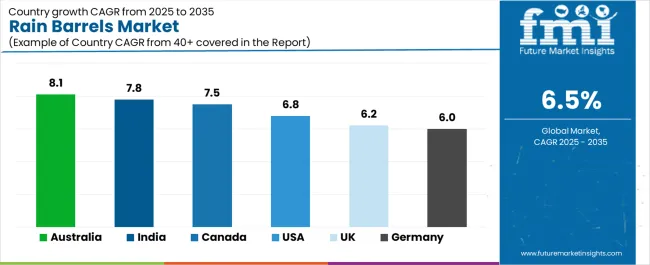
The rain barrels market demonstrates varied regional dynamics with Growth Leaders including Australia (8.1% growth rate) and Canada (7.5% growth rate) driving expansion through water conservation initiatives and residential adoption programs. Steady Performers encompass United States (6.8% growth rate), United Kingdom (6.2% growth rate), and developed regions, benefiting from established environmental awareness and home improvement market maturity. Emerging Markets feature India (7.8% growth rate) and developing regions, where water stress challenges and conservation programs support consistent growth patterns.
Regional synthesis reveals North American markets leading adoption through drought management programs and municipal incentive schemes, while Western European countries maintain steady expansion supported by environmental regulations and residential water conservation trends. Asia-Pacific markets show accelerating growth driven by water scarcity concerns and urban water management initiatives.
| Region/Country | 2025-2035 Growth | How to win | What to watch out |
|---|---|---|---|
| Australia | 8.1% | Focus on drought-resistant designs | Water policy changes; installation regulations |
| Canada | 7.5% | Emphasize freeze-resistant models | Seasonal limitations; short usage window |
| United States | 6.8% | Provide municipal rebate partnerships | Regional water laws; HOA restrictions |
| United Kingdom | 6.2% | Offer compact space-saving designs | Planning permissions; aesthetic requirements |
| India | 7.8% | Value-oriented capacity solutions | Infrastructure variability; distribution challenges |
| Germany | 6.0% | Push premium quality systems | Over-specification; lengthy approval processes |
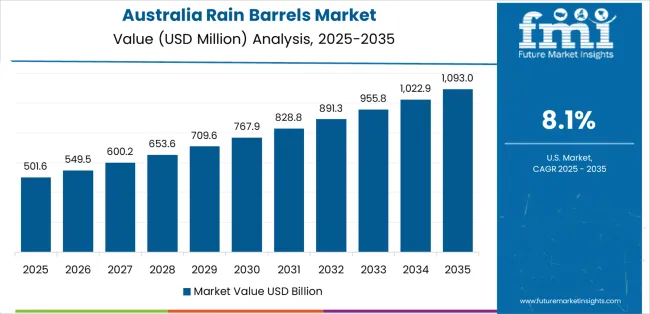
Australia establishes fastest market growth through aggressive water conservation programs and comprehensive drought management initiatives, integrating rain barrels as standard components in residential water harvesting and outdoor water use installations. The country's 8.1% growth rate reflects government initiatives promoting water conservation and residential collection capabilities that encourage the use of rainwater harvesting systems in residential and commercial properties. Growth concentrates in major urban centers, including Sydney, Melbourne, and Brisbane, where water restriction programs showcase integrated collection systems that appeal to homeowners seeking water conservation capabilities and utility cost reduction applications.
Australian manufacturers are developing drought-optimized collection solutions that combine local climate adaptation with advanced storage features, including high-capacity designs and integrated filtration capabilities. Distribution channels through home improvement retailers and landscape supply distributors expand market access, while government rebate programs support adoption across diverse residential and commercial segments.
Strategic Market Indicators:
In Toronto, Vancouver, and Calgary, residential properties and commercial facilities are implementing rain barrels as standard equipment for water conservation and garden irrigation applications, driven by increasing municipal water programs and environmental stewardship initiatives that emphasize the importance of water collection capabilities. The market holds a 7.5% growth rate, supported by provincial conservation programs and residential adoption trends that promote rainwater harvesting systems for residential and institutional properties. Canadian homeowners are adopting collection systems that provide reliable seasonal performance and freeze-resistant features, particularly appealing in regions where water conservation and outdoor irrigation represent important property management requirements.
Market expansion benefits from growing environmental awareness and municipal incentive programs that enable accessible adoption of water collection systems for residential and commercial applications. Technology adoption follows patterns established in home improvement markets, where cost-effectiveness and environmental benefits drive purchase decisions and operational deployment.
Market Intelligence Brief:
United States establishes market leadership through comprehensive water conservation programs and diverse residential market development, integrating rain barrels across residential and commercial water management applications. The country's 6.8% growth rate reflects established environmental awareness and mature home improvement market adoption that supports widespread use of water collection systems in residential and institutional properties. Growth concentrates in water-stressed regions, including California, Texas, and Arizona, where drought management programs showcase mature barrel deployment that appeals to homeowners seeking proven water conservation capabilities and utility cost savings applications.
American retailers leverage established distribution networks and comprehensive product offerings, including installation services and accessory packages that create customer relationships and purchase convenience. The market benefits from diverse municipal rebate programs and water conservation requirements that encourage rain barrel adoption while supporting technology advancement and capacity optimization.
Market Intelligence Brief:
United Kingdom's established environmental consciousness market demonstrates consistent rain barrel deployment with documented water conservation effectiveness in residential applications and garden irrigation through integration with existing property infrastructure and landscaping systems. The country leverages compact design expertise and space-efficient solutions to maintain a 6.2% growth rate. Urban centers, including London, Manchester, and Birmingham, showcase space-optimized installations where collection systems integrate with limited garden spaces and property management systems to optimize water usage and environmental performance.
British manufacturers prioritize aesthetic design and compact configurations in rain barrel development, creating demand for decorative systems with space-saving features, including slimline designs and wall-mounted options. The market benefits from established gardening culture and environmental consciousness that support investment in water conservation technologies providing long-term operational benefits and alignment with environmental objectives.
Market Intelligence Brief:
India's market expansion benefits from diverse water stress challenges, including residential water scarcity in urban centers, agricultural water management, and government conservation programs that increasingly incorporate rainwater harvesting solutions for water security applications. The country maintains a 7.8% growth rate, driven by rising urban water stress and increasing recognition of water collection benefits, including reliable water access and reduced dependency on municipal supplies.
Market dynamics focus on large-capacity collection solutions that balance functional water storage with affordability considerations important to Indian property owners. Growing urban development creates continued demand for water management systems in new residential infrastructure and commercial property projects.
Strategic Market Considerations:
Germany's advanced environmental technology market demonstrates sophisticated rain barrel deployment with documented water conservation effectiveness in residential applications and integrated landscape management through connection with existing garden irrigation systems and property infrastructure. The country leverages engineering excellence in water management technology and quality system integration to maintain a 6.0% growth rate. Residential areas showcase premium installations where collection systems integrate with comprehensive garden automation platforms and water management systems to optimize irrigation operations and resource effectiveness.
German manufacturers prioritize system quality and long-term durability in rain barrel development, creating demand for premium systems with advanced features, including automated overflow management and integrated filtration systems. The market benefits from established environmental standards and willingness to invest in quality water conservation technologies that provide extended operational life and compliance with environmental objectives.
Market Intelligence Brief:
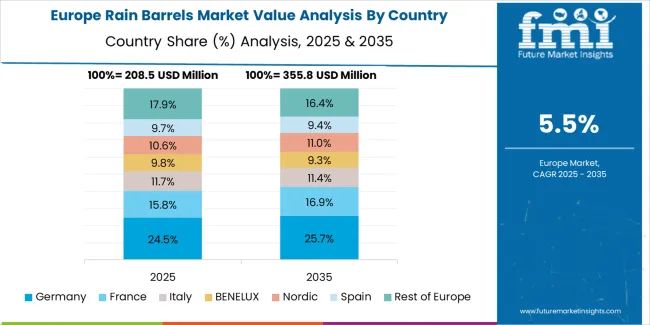
The European rain barrels market is projected to grow from USD 285 million in 2025 to USD 495 million by 2035, registering a CAGR of 5.7% over the forecast period. United Kingdom is expected to maintain its leadership position with a 32.4% market share in 2025, supported by its strong gardening culture and urban water conservation initiatives.
Germany follows with a 28.7% share in 2025, driven by comprehensive environmental programs and quality-focused residential adoption. France holds a 19.6% share through specialized residential applications and agricultural water management requirements. Netherlands commands a 9.8% share, while Spain accounts for 9.5% in 2025. The rest of Europe region is anticipated to gain momentum, expanding its collective share from 5.2% to 5.8% by 2035, attributed to increasing water conservation awareness in Nordic countries and emerging residential properties implementing rainwater harvesting programs.
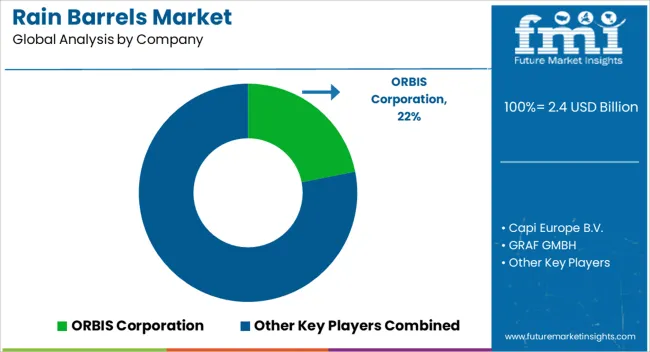
| Stakeholder | What they actually control | Typical strengths | Typical blind spots |
|---|---|---|---|
| Retail giants | Shelf space, pricing power, seasonal promotions | Broad availability, competitive pricing, installation support | Product innovation cycles; premium segment neglect |
| Design innovators | Aesthetic leadership; smart features; premium positioning | Latest features first; attractive margins on designer models | Volume scale limitations; distribution density |
| Regional manufacturers | Local production, custom sizing, nearby support | "Made locally" appeal; pragmatic pricing; quick delivery | Technology advancement; marketing reach |
| Online specialists | Direct-to-consumer, review aggregation, comparison tools | Transparent pricing; wide selection; customer education | Installation support gaps; regional shipping costs |
| Garden centers | Customer relationships, seasonal timing, landscape integration | Trusted advice; complementary products; installation referrals | Limited capacity scale; seasonal dependency |
| Item | Value |
|---|---|
| Quantitative Units | USD 0.9 billion |
| Material Type | Plastic, Wood, Metal, Fiberglass |
| Capacity | Small Capacity (up to 50 gallons), Medium Capacity (50-100 gallons), Large Capacity (above 100 gallons) |
| Design Type | Standard Barrels, Decorative Barrels, Collapsible Barrels |
| End Use | Residential Properties, Commercial Buildings, Institutional Facilities, Agricultural Operations |
| Regions Covered | North America, Latin America, Western Europe, Eastern Europe, East Asia, South Asia Pacific, Middle East & Africa |
| Countries Covered | United States, Canada, Australia, United Kingdom, Germany, India, France, Japan, Brazil, and 25+ additional countries |
| Key Companies Profiled | Good Ideas Inc., Gardener's Supply Company, Algreen Products, Enviro World Corporation, FCMP Outdoor, RTS Companies, Achla Designs, Exaco Trading Company, Rescue Brand, Koolatron Corporation |
| Additional Attributes | Dollar sales by material type and capacity categories, regional adoption trends across North America, Western Europe, and East Asia, competitive landscape with home improvement retailers and environmental product manufacturers, homeowner preferences for water conservation features and system durability, integration with irrigation systems and garden automation platforms, innovations in collection technology and capacity enhancement, and development of smart monitoring solutions with enhanced performance and residential water management capabilities. |
The global rain barrels market is estimated to be valued at USD 0.9 billion in 2025.
The market size for the rain barrels market is projected to reach USD 1.6 billion by 2035.
The rain barrels market is expected to grow at a 6.5% CAGR between 2025 and 2035.
The key product types in rain barrels market are plastic, wood, metal and fiberglass.
In terms of design type, standard barrels segment to command 58.0% share in the rain barrels market in 2025.






Our Research Products

The "Full Research Suite" delivers actionable market intel, deep dives on markets or technologies, so clients act faster, cut risk, and unlock growth.

The Leaderboard benchmarks and ranks top vendors, classifying them as Established Leaders, Leading Challengers, or Disruptors & Challengers.

Locates where complements amplify value and substitutes erode it, forecasting net impact by horizon

We deliver granular, decision-grade intel: market sizing, 5-year forecasts, pricing, adoption, usage, revenue, and operational KPIs—plus competitor tracking, regulation, and value chains—across 60 countries broadly.

Spot the shifts before they hit your P&L. We track inflection points, adoption curves, pricing moves, and ecosystem plays to show where demand is heading, why it is changing, and what to do next across high-growth markets and disruptive tech

Real-time reads of user behavior. We track shifting priorities, perceptions of today’s and next-gen services, and provider experience, then pace how fast tech moves from trial to adoption, blending buyer, consumer, and channel inputs with social signals (#WhySwitch, #UX).

Partner with our analyst team to build a custom report designed around your business priorities. From analysing market trends to assessing competitors or crafting bespoke datasets, we tailor insights to your needs.
Supplier Intelligence
Discovery & Profiling
Capacity & Footprint
Performance & Risk
Compliance & Governance
Commercial Readiness
Who Supplies Whom
Scorecards & Shortlists
Playbooks & Docs
Category Intelligence
Definition & Scope
Demand & Use Cases
Cost Drivers
Market Structure
Supply Chain Map
Trade & Policy
Operating Norms
Deliverables
Buyer Intelligence
Account Basics
Spend & Scope
Procurement Model
Vendor Requirements
Terms & Policies
Entry Strategy
Pain Points & Triggers
Outputs
Pricing Analysis
Benchmarks
Trends
Should-Cost
Indexation
Landed Cost
Commercial Terms
Deliverables
Brand Analysis
Positioning & Value Prop
Share & Presence
Customer Evidence
Go-to-Market
Digital & Reputation
Compliance & Trust
KPIs & Gaps
Outputs
Full Research Suite comprises of:
Market outlook & trends analysis
Interviews & case studies
Strategic recommendations
Vendor profiles & capabilities analysis
5-year forecasts
8 regions and 60+ country-level data splits
Market segment data splits
12 months of continuous data updates
DELIVERED AS:
PDF EXCEL ONLINE
RAIN Tag Antennas Market Size and Share Forecast Outlook 2025 to 2035
Rain Sensors Market Size and Share Forecast Outlook 2025 to 2035
Rainbow Flatware Market Trends - Growth & Forecast 2025 to 2035
Rain Boots Market Trends - Growth & Industry Forecast 2025 to 2035
Rainscreen Cladding Market Growth - Trends & Forecast 2025 to 2035
Market Share Breakdown of Rain Barrel Manufacturers
Grain Hardness Meter Market Size and Share Forecast Outlook 2025 to 2035
Grain Cooling Spear Market Size and Share Forecast Outlook 2025 to 2035
Train Antenna Market Size and Share Forecast Outlook 2025 to 2035
Brain Monitoring Market Size and Share Forecast Outlook 2025 to 2035
Brain Fitness Market Size and Share Forecast Outlook 2025 to 2035
Train Control and Management Systems Market Size and Share Forecast Outlook 2025 to 2035
Draining Cellulite Treatments Market Size and Share Forecast Outlook 2025 to 2035
Brain Computing Interfaces Market Size and Share Forecast Outlook 2025 to 2035
Brain Cancer Diagnostics Market Size and Share Forecast Outlook 2025 to 2035
Draining Agents Market Size and Share Forecast Outlook 2025 to 2035
Train Dispatching Market Size and Share Forecast Outlook 2025 to 2035
Grain Roller Market Size and Share Forecast Outlook 2025 to 2035
Brain Metastasis Therapeutics Market Analysis - Size, Share, and Forecast Outlook 2025 to 2035
Brain-Computer Interface Implant Market Analysis Size and Share Forecast Outlook 2025 to 2035

Thank you!
You will receive an email from our Business Development Manager. Please be sure to check your SPAM/JUNK folder too.
Chat With
MaRIA